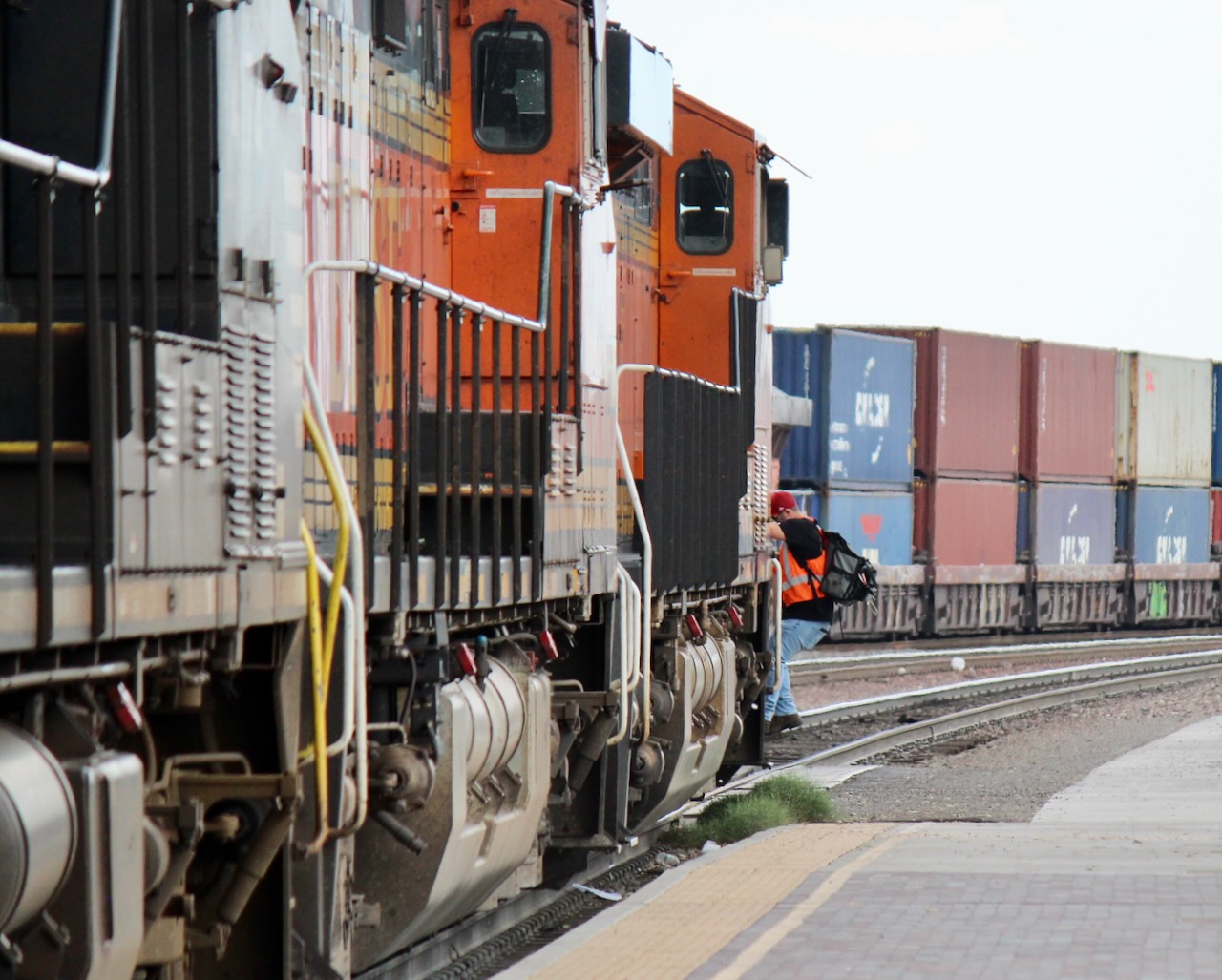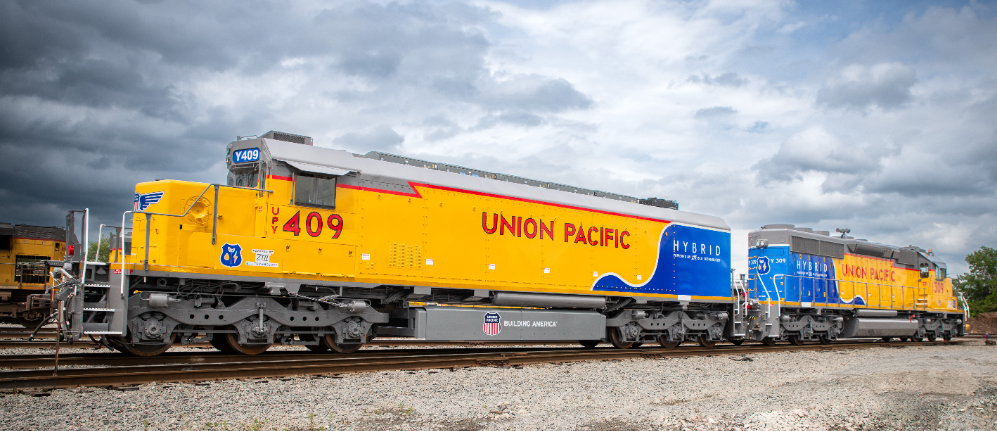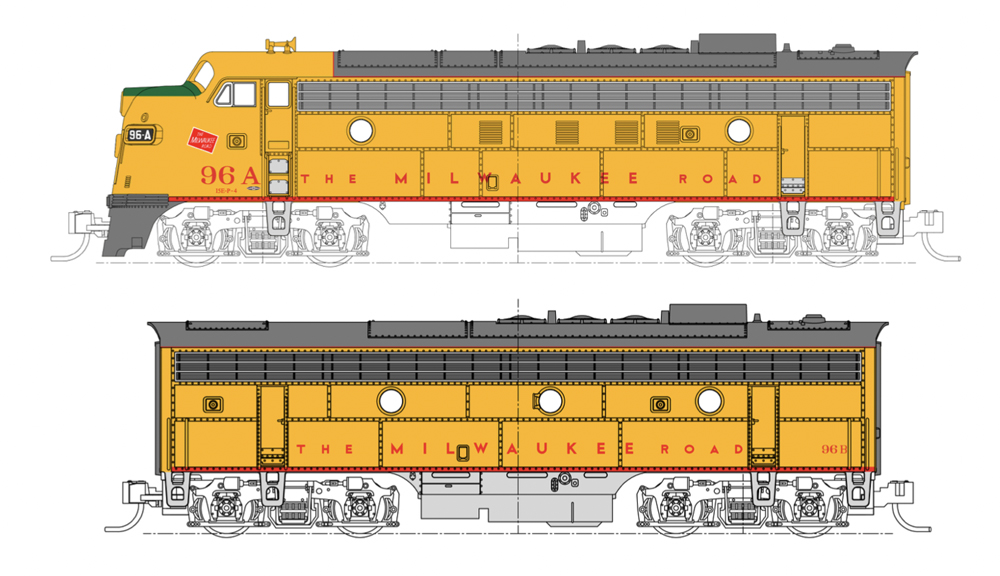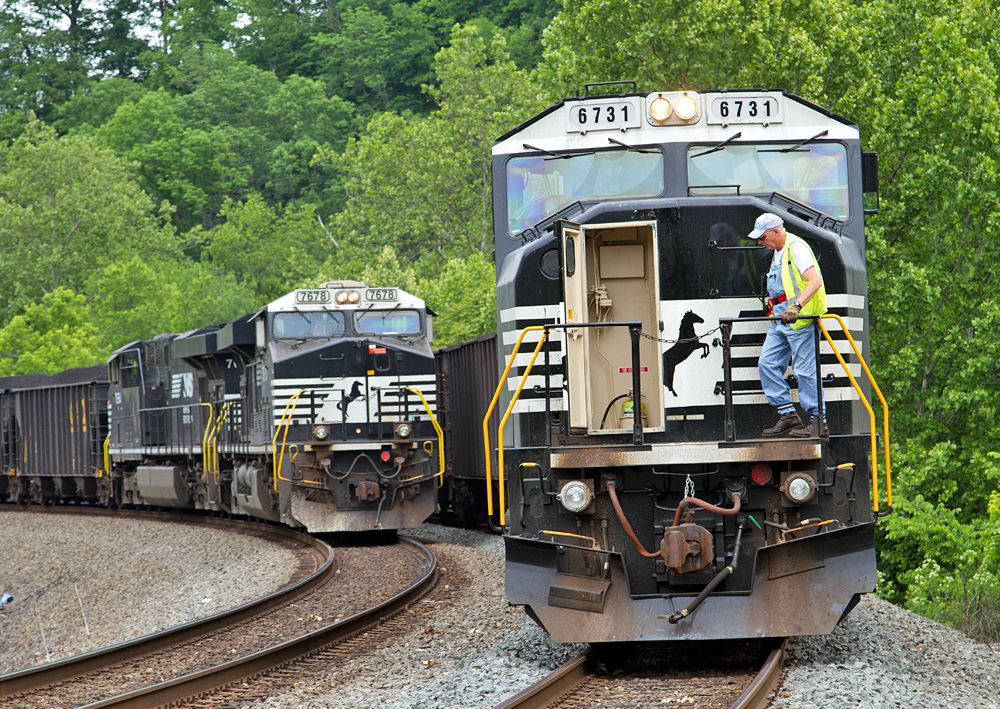
The industry would never admit it, but the Federal Railroad Administration has given the Class I railroads a gift in the form of its proposed two-person train crew rule.
Debate over the controversial rule has been framed almost entirely in safety terms. Having two people in the locomotive cab, the rule’s advocates say, is vital for the safety of the public, communities, and crew members, particularly in an era of ever-longer freight trains.
Yet it seems to me that if the SMART-TD union were ever to agree to taking conductors out of the cab — something the Class I railroads sought during the last round of national contract negotiations — it would quickly cause chaos out on main lines.
We don’t know whether two-person crews are safer than one-person crews, or vice versa. There’s just no conclusive data either way.
What we do know is that today’s massive freight trains tend to pull knuckles and encounter brake issues more frequently than shorter trains. This is simply due to the law of averages. The more cars you put in a train, the more troublemakers you’re likely to get in a consist that might stretch 15,000 feet.
Today when a freight train goes into emergency, the crew generally has no idea why. So the conductor hits the ground and walks the train to find the culprit. Then he or she has to fix the problem before walking back to the head end. It’s a process that can take hours.
Railroads want to create ground-based conductor positions, which would leave engineers alone in the cab. Putting conductors in pickup trucks, assigning them a territory, and having them respond to problems out on the main line may sound good to penny-pinching railroad executives — at least on paper. But out in the real world your mileage may vary.
Murphy’s Law being what it is, it wouldn’t take long for an engineer-only train to encounter a knuckle or brake-related problem on single track in the most isolated, godforsaken, hard to reach area on a subdivision.

Engineers can’t leave the cab. With no conductor to walk the train, and help from a ground-based conductor miles and even hours away, delays would mount. First to the waylaid train, then to the trains behind it and to oncoming traffic. Before long, the delays would cascade across the whole subdivision. And then the railroad grinds to a halt.
Although the scenario’s a bit better on a double-track main line, a disabled train eventually creates a single-track bottleneck, which also creates congestion and delays.
Umpteen million dollars’ worth of freight is stuck — and won’t arrive on time –— all because the railroad wants to save a buck or two on crew costs. It’s almost guaranteed that at least some of the delayed trains will require unplanned recrews, which only increases costs. And the late arrivals could be the last straw for some shippers, who would give up on rail and shift their freight to trucks.
If this sounds shortsighted, that’s because it is.
There may or may not be a safety case to make for two-person crews. But there sure is a railroad business case for keeping two people in the cab: It’s called service, which is the only thing that railroads sell to their customers. Until rail equipment becomes far more reliable, and failures on the line of road become extremely rare, engineer-only operation is a fool’s errand.
You can reach Bill Stephens at bybillstephens@gmail.com and follow him on LinkedIn and X @bybillstephens














I strongly disagree with Mr. Stephens.
While he is correct regarding exceptionally large trains operating on busy mainlines, he totally misses the point regarding serving the numerous smaller markets that collectively generate significant freight volume and represent a large amount of potential revenue for our railroad enterprises.
These smaller markets, taken together, represent a large potential volume and net income, but they must be served individually. They will never be able to produce or receive the exceptionally large trains Mr. Stephens references. They require the operation of smaller trains.
On these smaller trains the crew cost per revenue load becomes much more significant than it is on the large trains. The inane FRA regulation makes no distinction regarding train size. As a result, the railroads will continue to concede these markets to motor freight because the required rail service is not economical to operate. A one-person crew could safely and efficiently operate these required services. To ban such services by bureaucratic fiat is insane.
A salient example of such a market is the Sioux City, IA area. A whole lot of freight comes out of there. By truck.
Fair point! There are some shortlines/regionals out there that do have ample data demonstrating that a crew with one person in the cab and a “utility” crewman on call in a vehicle is just as safe as a two-person crew. Some local Class I jobs will always require two crew under the right circumstances, I can think of several jobs locally where if locals were scheduled to operate on back-to-back schedules, one utility person could handle the ground switching for one and then drive 15 miles to take care of the same on the other. That’s assuming, though, that everything goes as planned. And we all know how often that happens…….
An extreme example is any incident in a tunnel. I cannot imagine an engineer trying to escape toxic fumes by himself. How can same disconnect his loco(s) to skedaddle out of a tunnel?
Playing devil’s advocate here, I guess…
I live next to a Class 1 railroad and have observed how quickly ground crews are on the scene when a train has issues. While I initially thought a 1 person crew was insane on today’s super long trains, I’ve changed my mind after observing the railroad for many years.
The argument that railroad executives are looking to fire or eliminate conductors isn’t the proposal. The proposal is to move the conductor from the train’s cab to a company owned vehicle. How is this not a good idea? If I worked on the railroad, I personally would rather be able to drive my truck from my home to my job and hopefully be home at a reasonable time every day.
The argument that a train could have issues in remote areas that are difficult to reach by a ground based vehicle and thus a ground-based conductor is a bad idea implies that railroads would ONLY use one person crews on every train. Railroads would like the option to have a 1 person crew when it makes sense, not remove every conductor on every train regardless of if it makes sense or not. Trains operating in remote areas would likely still have two person crews if that is deemed necessary. It’s not like railroad exec don’t care if trains get stuck in the middle of nowhere…. trains that aren’t moving hurt the bottom line.
The argument that the engineer might fall asleep or have a health emergency and need a conductor to take over should no longer be an issue. Modern locomotives have cameras inside and out of the cab, not to mention that PTC will stop the train if the engineer is not responsive. I could see the engineer’s life being in danger if he/she has a heart attack and needs immediate CPR, but how often does that happen? Enough to justify a conductor on every train across the country every day?
From an engineer’s perspective, the one thing I could see as an argument against a single person crew is that it would sure seem lonely sitting in a cab by one’s self with no other real human interaction. Introverts, however, might love that job!
Despite my thinking that a 1 person crew would work-out just fine, I’m hoping the two person crew ruling remains… despite lack of a solid argument as to why.
A couple of thoughts. Maybe on territories which only have a dozen trains per day would be the ones where the total conductors needed if all were moved to trucks be the same as if when they were all in cabs. However, on busy lines with 20 or 30 or 40 or more trains per day, especially where there is no line of road work picking up or setting out, all those conductors which were in the cab wouldn’t be needed in pickup trucks, right?
Putting complete 100% trust in railroad executives to make the right decisions seems questionable when nearly all the Class 1’s shed employees in the big economic slow down of the pandemic and then were caught flat footed when business boomed back so soon and didn’t have the employees to run the trains.
The alertor will stop a train if the engineer becomes disabled. Nobody will know what happened until someone is sent to investigate unless there are onboard cameras that can be monitored remotely.
If a class 1 is running 3 mile long freight trains carrying 10’s of millions of dollars worth of material and the only way to make a profit is to cut some conductor jobs then the company is in trouble already.
Mr. Stephens does not have access to the operational data. He has no means of evidence. Never trust a man that makes strong evidence-free declarations
Did he not say there isn’t good data?
My railroading career started as a Management Trainee and thus never worked a union job. However, I have spent enough time riding on the headend to say that my response to the railroads claim that they have no data to show that one-man crews are just as safe, would be to ask where on your conductor’s trip report dose he puts down the number of times where he woke the engineer up or the engineer woke him up?
My example above is in the context of a road freight being on the road 8 -12 hours. In the case of a twenty-mile short line making stops along the way, I could see one person in the cab and the other in a pickup truck who could go ahead, line switches and open gates into industries.
Mr. Powell,
Way back when I was an engine service employee (fireman) and in my teen the max allowed on duty hours was 16 hours. If the crew went to beans it too often involved alcohol. So yes, I’d had to awaken both the head man and the engineer from their boozy naps more often than most would care to know.
I’m a former operation official and can assure you that there are many, many places along railroads where NO pickup truck or jeep could hope to reach because of wild, dangerous territory.
As I posted in another thread. Between the engine and the consist, place a small platform car to carry a truck. If the train has to stop, lower the truck down and let the 2nd engineer go examine the consist.
Or have a smaller vehicle (like a 4 wheeler) kept on a rack on the back of the engine. Same idea, lower the rack and have the engineer perform the inspection.
I like that idea, though it’s too easy for the suits to understand.
Except there are many, many places on the U.S. railroad network where even a four-wheeler would have difficultly along the right of way. Think of the $$$$ the railroads would have to spend so said vehicles can drive over creeks? And given the nature of the thousands of miles of fills out there, the “2nd engineer” position would likely see lots of injuries due to rollovers. It won’t work without investments that would only have to be made if the railroads eliminated the second onboard person to begin with! And what’s the point of a second engineer? That sorta defeats the point of a single-man onboard crew, eh?
Since the crew doesn’t know what caused the problem, how do they know what to bring from the locomotive. Have you ever tried to carry a coupler knuckle, air hose, a pipe wrench, and a lantern at the same time? On a two mile long train you are talking about a 20 minute walk to the rear of the train each way, not an easy task at all.
Two miles in twenty minutes, six MPH, is a pretty good pace on a smooth level ground never mind a rail bed or dirt service road.
Right on. One factor I have never seen discussed in the two-crew to one scenario is what happens if THE engineer suffers a disabling medical problem – and the train is rolling. When and how will it stop. Will PTC help? Not all tracks have it anyway. A downgrade ahead could be pretty sticky. Even if the last effort puts the train into emergency, may not be enough.
Such an event could be very expensive for that railroad AND its officers.
But in the back on the mind everyone’s fear/dream is the old New York State Five-Man crew law which lasted until 1989. Will that be brought back in time for next November’s Election along
with the forgiving of ALL student loans?
Way to shove your political views into a discussion about railroad train crew makeup.
Thomas Wngel is right. Our government (before Biden but moreso with Biden) is an unforgiveable horror show.
I’m totally in favor of two-man crews. It should come from railroad operations and railroad risk management. Not from Washington DeeCee which can’t begin to manage its own affairs.
Where did you get this nonsense from, Thomas? Perhaps a 5 man crew law was on the books, but in 1981 three man crews became standard and in the mid 80s 2 man crews were standard.
Really tired of your politics Mr. Landey,
Why don’t you save your political opinions for somewhere else more appropriate.
CHRIS — The topic is political. It concerns a rule from FRA which is part of the Biden administration. Thus my political comment. Thanks!!!
Ok Charles whatever you say.
” Our government (before Biden but moreso with Biden) is an unforgiveable horror show.” Really Charles, where you for the 4 year circus that was the orange clowns doing including trying to overthrow the Constitution of the United States on January 6th. How about the embarrassment of a United States of America former President being indicted not once but 91 times. A conviction for rape also I will remind you of. Yet let’s hear about this so-called Biden crime family Charles that Comer and Gym Jim can’t come up with one shred of evidence against yet turn their head at the $2 Billion Jared received from the Saudis. Please keep spinning tales for us Charles.
Bill, your argument cuts both ways. Hours could be saved should a train separation happen in close proximity to the ground personnel. That would save time and effort keeping trains moving.
So the RR should plan accidents near the ground personnel?